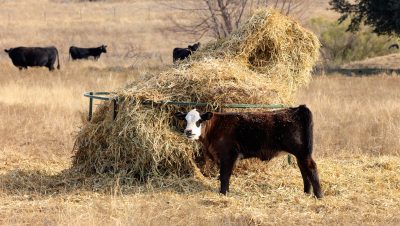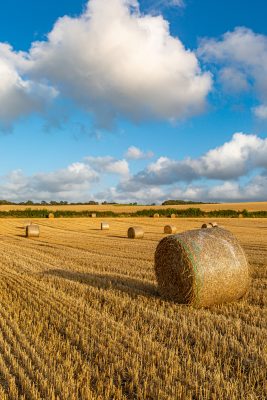More and more beef producers nationwide are having their hay sampled to analyze its nutrient content as part of their yearly routine. This relatively simple and affordable exercise allows cattlemen an in-depth look at the actual nutrient profile their herd will receive from hay, allowing them to plan supplemental feed programs accordingly.
However, before a hay analysis can be effectively put to use, it has to be understood. Depending on the lab performing the analysis, you may receive back a simple list of nutrients next to the corresponding measured value, with no indication of whether the value is high, average, or low compared to similar feeds. The nutrients themselves may only appear as abbreviations and could include a long list of measured and calculated components, some of which are more important than others depending on the operation.
This article will go through a basic break down of key nutrient components found in most routine hay analyses, as well as the relative values to look for in each.
Moisture
Typically, the first values you’ll find on a hay analysis report are moisture and dry matter (DM), a means of comparing the amount of water within different feeds. This is determined by drying the hay in an oven and then weighing all non-water components.
Nutrient values will often be reported as both dry matter (DM) and “as-fed” (AF) or “as received”. Hay should be compared to other feeds using the DM value for nutrients. For the rest of this article, values for other nutrient measurements will be discussed on a DM basis.
Moisture level also greatly influences the stability of harvested forage during storage. The target for hay is around 85% DM, or 15% moisture. Baleage is usually 40 to 60% DM, and silage should be 30 to 40% DM for proper fermentation. You’ll notice some moisture should remain, as being 100% water-free decreases palatability and leads to leaf shatter.
Crude Protein
Protein in ruminant feeds is usually expressed as crude protein, or CP, as a percentage of DM. This is based on the total nitrogen in the plant matter multiplied by 6.25, as plant protein is typically 16% nitrogen (100 ÷ 16 =6.25). Crude protein can be used for ruminants, including cattle, because their unique gastrointestinal tract allows them to convert nonprotein nitrogen into microbial protein in the rumen.
 Crude protein level is critical for a productive beef herd. Sufficient protein is required for growth, lactation, reproduction, and muscle development. This is why protein is the one of the most commonly supplemented nutrients for grazing or hayed cattle.
Crude protein level is critical for a productive beef herd. Sufficient protein is required for growth, lactation, reproduction, and muscle development. This is why protein is the one of the most commonly supplemented nutrients for grazing or hayed cattle.
It is also the most expensive. Dry gestating cows need at least 7% CP on a daily basis (7% value is also considered the bare minimum for wintering cattle, as this is lowest level needed to support rumen function). For at least the first 60 days after calving, a cow’s needs increase to 11% CP. Throughout the rest of lactation cows need at least 9% CP. Growing rations for calves typically contain 14 to 16% CP. Crude protein can vary based on forage species, maturity, soil, and storage stability.
Fiber
The fiber content of the forage is made up of the structural components in the grasses’ cell wall and is usually broken into neutral detergent fiber (NDF) and acid detergent fiber (ADF), both expressed as a percentage of dry matter. Neutral detergent fiber contains the components cellulose, hemicellulose, and lignin, and is what remains after the digestible material is removed with a neutral detergent.
Forage intake will decrease as NDF increases and dividing 120 by NDF (%) can help determine how much the animal will eat as a percentage of body weight. For example, if NDF is 50%, dry matter intake will be 2.4% of the animal’s weight. Neutral detergent fiber can range from 40 to 65% DM, and at 60% and higher begins to noticeably decrease feed intake. Lower values are typically desired for NDF.
Acid detergent fiber is what remains after remaining NDF has been removed with acid detergent. Forage digestibility decreases with increased ADF.
Average ranges for ADF in hay are anywhere from 30 to 45% DM. Values above 40% ADF indicate a lower quality hay. Both forms of fiber increase with plant maturity and are typically lower in legumes than grasses.
Energy
Energy in a feed can be measured in several ways. The most common and practical way to evaluate energy content of a forage is total digestible nutrients, or TDN. Total digestible nutrients are also expressed as a percentage of dry matter, and are the sum of digestible carbohydrates, protein, and fat the animal will receive.
In general, hay with less than 52% TDN would be considered lower quality, hay with 52% to 58% TDN would be medium or average quality and hay exceeding 58% would be high quality. Based on the 2016 “Nutrient Requirements of Beef Cattle, Eighth Revised Edition”, mature cows that are nursing calves need a minimum of 58 to 61% TDN in their diet, whereas a dry pregnant cow should be getting at least 50 to 54% TDN, depending on stage of pregnancy.
These values can easily be converted to pounds by multiplying the percentage of TDN by the total pounds of dry matter the animal eats per day.
Minerals
Both macrominerals and trace minerals are critical for cattle growth and performance, and several will show up on a good hay analysis. Two of the key minerals you should look for are calcium (Ca) and phosphorous (P), both usually reported as a percentage of total DM. These are both needed for skeletal growth in growing cattle and are crucial for lactation.
Dry cows need 0.25% to 0.28% Ca and 0.16% to 0.19% P a day in their diets. Cows at peak lactation need at least 0.31% Ca and 0.21% P per day. The ratio of calcium to phosphorous should remain between 1.5:1 and 4:1, because too much phosphorous can impede calcium absorption. Most common complete mineral mixes are sufficient to provide cattle with enough calcium and phosphorous.
Calculated Values (RFV & RFQ)
Several values can be calculated based on other results from a hay sample. Relative Feed Value (RFV) and Relative Forage Quality (RFQ) are calculated values and meant to combine energy content and dry matter intake into a single value, which is measured against full bloom alfalfa as a standard (full bloom alfalfa is assumed to have RFV=100). These are meant to provide an idea of how well a forage would provide for a ruminant animal if that was all that was being fed. Both may appear on a hay sample analysis. However, depending on the lab, these may need to be specifically requested. 
Relative Feed Value was developed first, calculated using the measured values for ADF and NDF in the sample. The problem is that RFV isn’t accurate across forage types, such as when comparing good grass hay to legumes, so RFQ was developed using TDN as part of the calculation. RFQ is considered a better judge of true potential for a forage to predict animal performance.
In most cases, RFQ will range from 50 to 250. In hay, RFQ < 90 = low quality, 90-110 = fair quality, 111-140 = good quality, 141-200 = premium hay, > 200 = outstandingly high-quality hay. Dry cows can get by on hay in the 100 to 115 range, whereas growing cattle and lactating cows really need hay in the 115 to 140 range.
A good hay analysis can provide a tremendous amount of information about the actual nutrition your herd is receiving. But the data you get back can be difficult to sort through, especially without a good frame of reference for what the values and nutrient components mean. Some values are extremely important to pay attention to and can go a long way in formulating a good supplementation program for your herd. Others may not be as crucial.
If you still have questions or want to be sure your interpretation is correct, reach out to your local extension personnel for assistance. A list of county extension offices for Wyoming can be found at https://www.uwyo.edu/uwe/county-offices.html.




